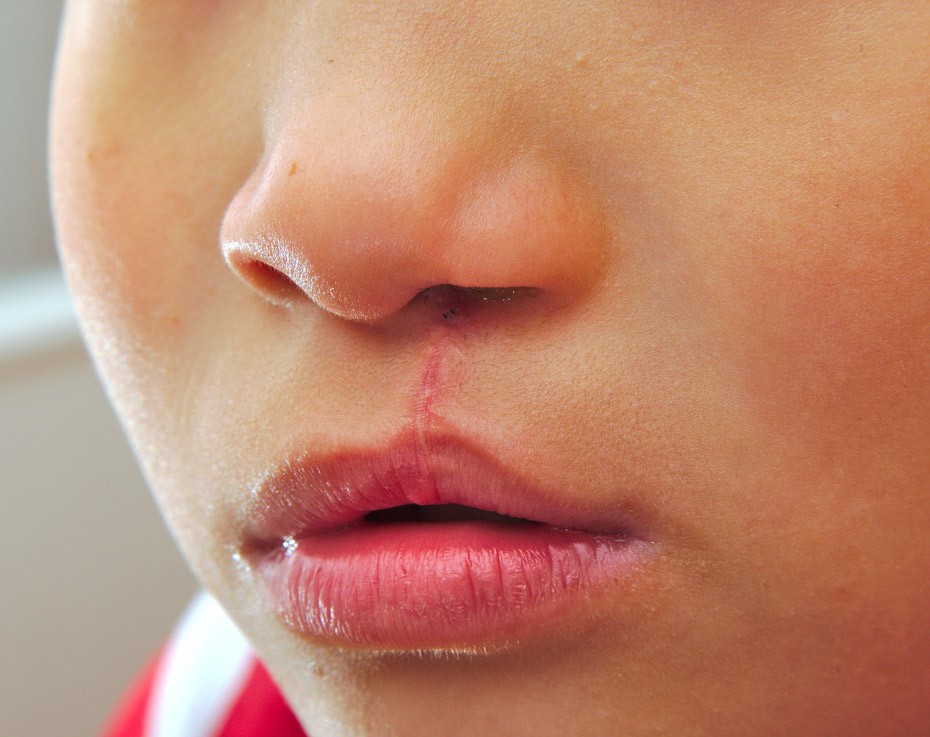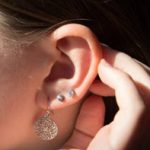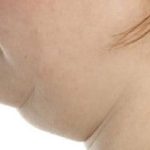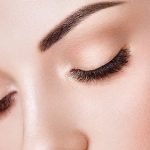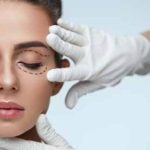What is a cleft lip and cleft palate?
Cleft lip and cleft palate, also known as orofacial cleft, is a group of conditions that includes cleft lip, cleft palate and both together.. A cleft lip contains an opening in the upper lip that may extend into the nose. The opening may be on one side, both sides, or in the middle. A cleft palate is when the roof of the mouth contains an opening into the nose.
Cleft lip and palate are the result of tissues of the face not joining properly during development. As such, they are a type of birth defect. The cause is unknown in most cases.
A cleft lip or palate can be successfully treated with surgery. This is often done in the first few months of life for cleft lip and before eighteen months for cleft palate. Speech therapy and dental care may also be needed. With appropriate treatment and properly skilled surgeons, outcomes are excellent.
Cleft lip and palate occurs in about 1 to 2 per 1000 births in the developed world. Cleft lip is about twice as common in males as females, while Cleft palate without cleft kip is more common in females.
Operation of Hope vows that all individuals are treated pro bono. Our team of skilled surgeons and specialists have been fortunate to impact the lives of many with life changing results.
 What are cleft lip and cleft palate in children?
What are cleft lip and cleft palate in children?
Cleft lip and palate are openings or splits in the upper lip or roof of the mouth (palate). A child can be born with a cleft lip, cleft palate, or both. Cleft lip and palate may be the only birth defects, or they may happen with other defects.
A cleft lip may be as mild as a notch of the lip. Or it may be as severe as a large opening from the lip to the nose.
A cleft palate may leave an opening that goes into the nasal cavity. Cleft palate is not as noticeable as cleft lip because it is inside the mouth.
COST OF CLEFT LIP REPAIR/CLEFT PALATE REPAIR IN IRAN
The cost of cleft surgery depends on the patient’s condition i.e. defect severity. Usually, for a cleft lip repair in Iran, you would be charged from around $2,000 to $4,000. Cleft palate surgery in Iran would cost around $3,000 to $4,000. This is while the same procedures cost from $5,000 to $20,000 and more in western countries.
What causes cleft lip and palate in a child?
Cleft lip and palate happen when a baby develops in the womb. Researchers don’t know the exact cause of cleft lip and palate. It can be caused by genes passed on from parents, as well as environmental factors. Environmental factors include taking certain medicines during pregnancy, smoking or drinking alcohol during pregnancy.
More than a cosmetic repair
Surgery to repair a cleft of the lip or palate is highly individualized. Surgery is intended to close the cleft defect, but also to help your child ability to function and grow normally. Cleft lip repair, also called cheiloplasty, includes reconstruction of the lip to create a more normal appearance, namely:
- Closure of the cleft resulting in a scar located within or near the typical features of the upper lip
- Formation of a cupid’s bow (the curves along the center of the upper lip)
- Establishing adequate distance between the upper lip and nose
Clefts of the upper lip typically affect the shape of the nose and additional procedures may be recommended to:
- Restore nasal symmetry and nostril shape
- Straighten and create adequate length for the columella (the tissue that separates the nostrils)
Because the palate creates the floor of the nasal cavity and is responsible for allowing normal speech, considerations in repairing a cleft palate include:
- Separating the mouth and nasal tissues by closing the defect along its length
- Re-establishing soft palate muscle function to promote normal speech
- Recreating normal relation of the soft palate to the auditory canal and Eustachian tube to allow for normal hearing
- Promoting as much as possible the normal growth and development of the upper jaw and teeth
- Repairing, when appropriate, any defects in the gumline to allow for permanent tooth eruption
When should my child have the surgery?
The timing of the cleft repairs depends on the individual circumstances of your child.
- Cleft lip repairs are typically performed between 2 and 6 months of age depending on your child’s health status and local cleft team protocols.
- Cleft palate repairs are generally performed after cleft lip repair in a separate surgery when the child is between 9 to 18 months of age depending on health status and local cleft team protocols.
- Cleft lip and/or palate repair may be delayed in order to treat other, more life-threatening problems that may be present such as a heart or lung disorder.
- Depending on the severity of the cleft, pre-operative interventions such as cleft lip taping, orthodontic molding (called NasoAlveolar Molding – NAM), or staged surgery techniques may be recommended.
- Other cleft-related surgeries may be needed over time including ear tubes to treat fluid buildup, bone grafting to repair the gumline, and dental or jaw surgery to improve bite relationships
How do doctors fix a cleft lip and cleft palate?
Treating cleft lip and cleft palate depends on the extent of the cleft, the child’s age and other special needs or health conditions. Surgery is performed at a hospital, and the child gets anesthesia so they are asleep during the procedure.
Cleft lip repair
A cleft lip repair may require one or two surgeries. The first surgery usually occurs when the baby is between 3 and 6 months old. This surgery closes the infant’s lip. The second surgery, if necessary, is usually done when the child is 6 months old.
Several techniques can improve the outcomes of cleft lip and palate repairs when used appropriately before surgery. They are non-invasive and dramatically change the shape of the baby’s lip, nose and mouth:
- A lip-taping regimen can narrow the gap in the child’s cleft lip.
- A nasal elevator helps form the correct shape of the baby’s nose.
- A nasal-alveolar molding (NAM) device may be used to help mold the lip tissues into a more favorable position in preparation for lip repair.
Cleft palate repair
A cleft palate repair is performed at 12 months and creates a working palate and reduces the chances that fluid will develop in the middle ears. To prevent fluid buildup in the middle ear, children with cleft palate usually need special tubes placed in the eardrums to aid fluid drainage, and their hearing needs checked once a year.
Up to 40% of children with a cleft palate need further surgeries to help improve their speech. A speech pathologist assesses speech between ages 4 and 5. They may use a nasopharyngeal scope to check the movement of the palate and throat. If surgery is needed to improve speech, this surgery is usually performed around age 5.
Children with a cleft involving the gum line may also need a bone graft when they are between 6 and 10 to fill in the upper gum line so that it can support permanent teeth and stabilize the upper jaw. Once the permanent teeth grow in, a child will often need braces to straighten the teeth and a palate expander to widen the palate.
Additional surgeries could include surgery to:
- Improve the appearance of the lip and nose.
- Close openings between the mouth and nose.
- Help to breathe.
- Stabilize and straighten the jaw.
Possible risks to surgery include bleeding, infection and damage to nerves, tissues or other structures. Surgery is usually successful, and risks are low. Cleft lip surgery leaves a small pink scar that should shade over time and become less noticeable as the child grows.
How should the dental care needs of children with cleft lips or palates be met?
Generally, the dental care needs of children who have clefts are the same as other children. However, children with cleft lip and palate may have missing, misshapen or poorly positioned teeth. Some recommendations include:
- Early dental care: Like other children, children with cleft lip and cleft palate require proper cleaning, good nutrition and fluoride treatment to have healthy teeth. Appropriate cleaning with a small, soft-bristled toothbrush should begin as soon as teeth appear. If a soft children’s toothbrush doesn’t adequately clean the teeth because of the different shape of the mouth and teeth, the dentist may recommend a soft, mouthwash-containing sponge on a handle to swab the child’s teeth. Many dentists recommend that the first dental visit be scheduled at age 1 or earlier if there are problems. Routine dental care can begin around 3.
- Orthodontic care: After permanent teeth appear, an orthodontist can further evaluate a child’s short and long-term dental needs. Most children with a cleft palate will require palatal expansion around age 6 or 7. After all the permanent teeth erupt, an orthodontist can align the teeth with braces. Orthodontic care is also required in preparation for jaw surgery (orthognathic surgery).
- Prosthodontic care: A prosthodontist may make a dental bridge to replace missing teeth, or special appliances called “speech bulbs” or “palatal lifts” to help close the nose from the mouth so that speech sounds more normal. The prosthodontist coordinates treatment with the oral or plastic surgeon and the speech pathologist.




